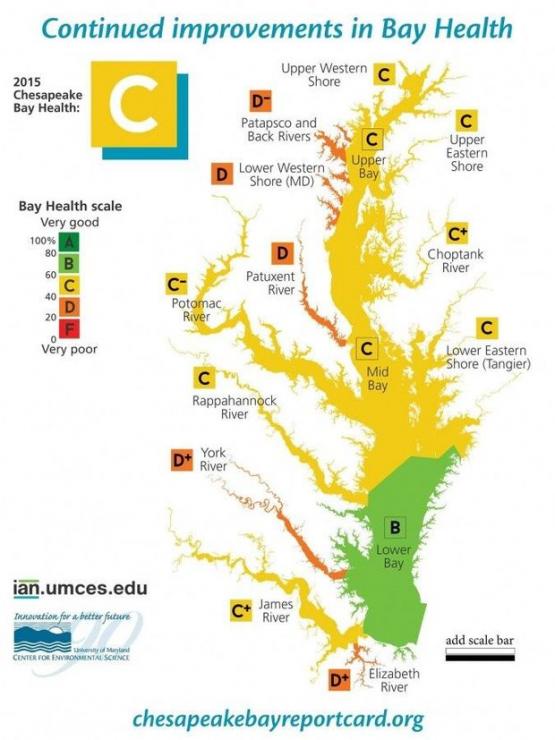 According to researchers at the University of Maryland Center for Environmental Science, the Chesapeake received a "C" on its health report card for 2015, the highest score in a non-drought year since 1992 and the third consecutive year of improvement. It is also one of the three highest scores since 1986.
The annual survey compares seven indicators to scientific thresholds, which are combined into an overall health index, represented as a percentage toward a broad set of ecosystem goals. The Chesapeake Bay, the country's largest estuary, scored a C or 53%.
Water clarity increased from 2014 to 2015, along with the prevalence of aquatic grasses, blue crab, bay anchovy, and striped bass populations. Nitrogen and phosphorous pollution had decreased. Unfortunately Baltimore's Inner Harbor and the tidal Patapsco River received a failing grade for 2015. The Gwynns Falls and Back River received Ds.
University of MD researchers attribute the overall improvement to "cleaner air, cleaner water, and cover crop programs that protect against wind and water erosion" according to CNN.
There is also a $500 million project currently in the works that would improve the flow of sewage into the Back River Wastewater Treatment Plant. The project is to be completed by 2020. This, along with the Clean Air Act and an incentive program for farmers to plant cover crops to alleviate runoff into the Bay have begun, slowly, to improve the health of the Bay. But there's still a long way to go.
Map courtesy Chesapeake Bay Foundation.
According to researchers at the University of Maryland Center for Environmental Science, the Chesapeake received a "C" on its health report card for 2015, the highest score in a non-drought year since 1992 and the third consecutive year of improvement. It is also one of the three highest scores since 1986.
The annual survey compares seven indicators to scientific thresholds, which are combined into an overall health index, represented as a percentage toward a broad set of ecosystem goals. The Chesapeake Bay, the country's largest estuary, scored a C or 53%.
Water clarity increased from 2014 to 2015, along with the prevalence of aquatic grasses, blue crab, bay anchovy, and striped bass populations. Nitrogen and phosphorous pollution had decreased. Unfortunately Baltimore's Inner Harbor and the tidal Patapsco River received a failing grade for 2015. The Gwynns Falls and Back River received Ds.
University of MD researchers attribute the overall improvement to "cleaner air, cleaner water, and cover crop programs that protect against wind and water erosion" according to CNN.
There is also a $500 million project currently in the works that would improve the flow of sewage into the Back River Wastewater Treatment Plant. The project is to be completed by 2020. This, along with the Clean Air Act and an incentive program for farmers to plant cover crops to alleviate runoff into the Bay have begun, slowly, to improve the health of the Bay. But there's still a long way to go.
Map courtesy Chesapeake Bay Foundation.
Friday, May 20, 2016 - 12:00
 According to researchers at the University of Maryland Center for Environmental Science, the Chesapeake received a "C" on its health report card for 2015, the highest score in a non-drought year since 1992 and the third consecutive year of improvement. It is also one of the three highest scores since 1986.
The annual survey compares seven indicators to scientific thresholds, which are combined into an overall health index, represented as a percentage toward a broad set of ecosystem goals. The Chesapeake Bay, the country's largest estuary, scored a C or 53%.
Water clarity increased from 2014 to 2015, along with the prevalence of aquatic grasses, blue crab, bay anchovy, and striped bass populations. Nitrogen and phosphorous pollution had decreased. Unfortunately Baltimore's Inner Harbor and the tidal Patapsco River received a failing grade for 2015. The Gwynns Falls and Back River received Ds.
University of MD researchers attribute the overall improvement to "cleaner air, cleaner water, and cover crop programs that protect against wind and water erosion" according to CNN.
There is also a $500 million project currently in the works that would improve the flow of sewage into the Back River Wastewater Treatment Plant. The project is to be completed by 2020. This, along with the Clean Air Act and an incentive program for farmers to plant cover crops to alleviate runoff into the Bay have begun, slowly, to improve the health of the Bay. But there's still a long way to go.
Map courtesy Chesapeake Bay Foundation.
According to researchers at the University of Maryland Center for Environmental Science, the Chesapeake received a "C" on its health report card for 2015, the highest score in a non-drought year since 1992 and the third consecutive year of improvement. It is also one of the three highest scores since 1986.
The annual survey compares seven indicators to scientific thresholds, which are combined into an overall health index, represented as a percentage toward a broad set of ecosystem goals. The Chesapeake Bay, the country's largest estuary, scored a C or 53%.
Water clarity increased from 2014 to 2015, along with the prevalence of aquatic grasses, blue crab, bay anchovy, and striped bass populations. Nitrogen and phosphorous pollution had decreased. Unfortunately Baltimore's Inner Harbor and the tidal Patapsco River received a failing grade for 2015. The Gwynns Falls and Back River received Ds.
University of MD researchers attribute the overall improvement to "cleaner air, cleaner water, and cover crop programs that protect against wind and water erosion" according to CNN.
There is also a $500 million project currently in the works that would improve the flow of sewage into the Back River Wastewater Treatment Plant. The project is to be completed by 2020. This, along with the Clean Air Act and an incentive program for farmers to plant cover crops to alleviate runoff into the Bay have begun, slowly, to improve the health of the Bay. But there's still a long way to go.
Map courtesy Chesapeake Bay Foundation.